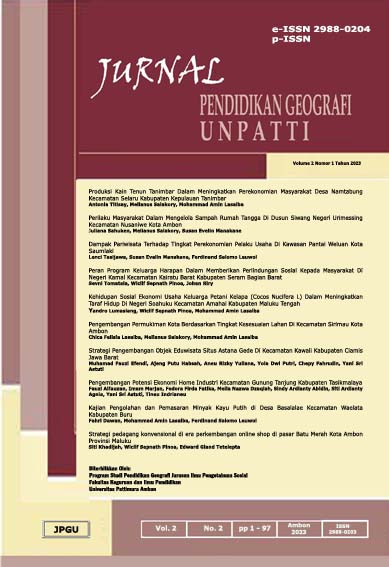Landslide Susceptibility Analysis Based on Geographic Information System in Ambon City
Analisis Tingkat Kerawanan Longsor Lahan Berbasis Sistem Informasi Geografi di Kota Ambon
Abstract
Disaster is an event that threatens and disrupts people's lives and livelihoods. Landslide is one type of mass movement of soil or rock, or a mixture of both, down a slope due to disruption of soil stability. The cause of landslides apart from human activity is also due to natural factors, namely rain. There are two things that cause landslides related to rain, namely high-intensity rain in a short time and hitting areas with unstable soil conditions. Geographic information system (GIS) also provides spatial data, which can be used for landslide hazard inventory and zoning maps, Geographic Information System used in this study because it is proven to be able to provide geospatial data information for each object on the earth's surface quickly, as well as provide a spatial analysis system that so that mitigation efforts can be carried out aimed at preventing hazards (risks) from becoming disasters or reducing the effects that occur when the disaster hasoccurred Ambon City based on its physiography, most of its areas are hilly to mountainous areas, about 89% with slope conditions up to steep and only about 11% in the form of plains.
Downloads
References
Ahmed, K. A., Khan, S., Sultan, M., Bin Nisar, U., Mughal, M. R., & Qureshi, S. N. (2020). Landslides assessment using geophysical and passive radon exhalation detection techniques in Murree Hills, northern Pakistan: Implication for environmental hazard assessment. Journal of Earth System Science, 129(1). https://doi.org/10.1007/s12040-019-1327-y
Benchelha, S., Chennaoui Aoudjehane, H., Hakdaoui, M., Hamdouni, R. E. L., Mansouri, H., Benchelha, T., Layelmam, M., & Alaoui, M. (2020). Landslide susceptibility mapping in the commune of Oudka, Taounate Province, North Morocco: A comparative analysis of logistic regression, multivariate adaptive regression spline, and artificial neural network models. Environmental and Engineering Geoscience, 66(1), 185–200. https://doi.org/10.2113/EEG-2243
Bhat, I. A., Shafiq, M. ul, Ahmed, P., & Kanth, T. A. (2019). Multi-criteria evaluation for landslide hazard zonation by integrating remote sensing, GIS and field data in North Kashmir Himalayas, J&K, India. Environmental Earth Sciences, 78(20), 1–15. https://doi.org/10.1007/s12665-019-8631-3
BNPB. (2016). Risiko Bencana Indonesia (Disasters Risk of Indonesia). International Journal of Disaster Risk Science, 22. https://doi.org/10.1007/s13753-018-0186-5
Enigda, E. A., & T, S. (2021). Landslide Evaluation In Parts of Tarmaber District (Debresina), Central Ethiopia; An Expert Evaluation Approach. International Journal of Geoinformatics and Geological Science, 8(1), 15–26. https://doi.org/10.14445/23939206/ijggs-v8i1p103
Gong, Q., Wang, J., Zhou, P., & Guo, M. (2021). A Regional Landslide Stability Analysis Method under the Combined Impact of Rainfall and Vegetation Roots in South China. Advances in Civil Engineering, 2021. https://doi.org/10.1155/2021/5512281
He, S., Wang, J., & Liu, S. (2020). Rainfall event-duration thresholds for landslide occurrences in China. Water (Switzerland), 12(2). https://doi.org/10.3390/w12020494
Juang, C. S., Stanley, T. A., & Kirschbaum, D. B. (2019). Using citizen science to expand the global map of landslides: Introducing the cooperative open online landslide repository (COOLR). PLoS ONE, 14(7), 1–28. https://doi.org/10.1371/journal.pone.0218657
Lasaiba, M. A. (2013). Kajian Keruangan Penggunaan Lahan Dalam Pengembangan Kota Ambon Berbasis Ekologi. Jurnal Pendidikan Geografi UNESA, 11(21), 34–56.
Lasaiba, M. A. (2016). Dimensi Spasial Karakteristik Sebaran Dan Deviasi Pola Pegunungan Lahan Terhadap Ekosistem Pesisir Di Kota Ambon. Jendela Pengetahuan, 9(1), 24–34.
Lasaiba, M. A. (2022). Fenomena geosfer dalam perspektif geografi telaah substansi dan kompleksitas 1. 15(1), 1–14. https://ojs3.unpatti.ac.id/index.php/jp/article/view/6402/4501
Lasaiba, M. A., & Arfa, H. (2022). Spatial Distribution Of The Earthquake Episentrum Based On Geographic Information System ( Gis ) On Ambon Island. Jurnal Tunas Geografi, 11(1), 37–46. https://doi.org/https://doi.org/10.24114/tgeo.v11i1.34931
Lombardo, L., Opitz, T., & Huser, R. (2019). Numerical Recipes for Landslide Spatial Prediction Using R-INLA. In Spatial Modeling in GIS and R for Earth and Environmental Sciences. Elsevier Inc. https://doi.org/10.1016/b978-0-12-815226-3.00003-x
Rai, A., & Avenue, L. (2020). Use of Remote Sensing and Gis in. 9(1), 1–12.
Tewari, N. K., & Misra, A. K. (2019). Landslide vulnerability assessment in Gangotri valley glacier Himalaya through GIS and remote sensing techniques. Applied Water Science, 9(4), 1–10. https://doi.org/10.1007/s13201-019-0992-y
Tran, T. H., Dam, N. D., Jalal, F. E., Al-Ansari, N., Ho, L. S., Phong, T. Van, Iqbal, M., Le, H. Van, Nguyen, H. B. T., Prakash, I., & Pham, B. T. (2021). GIS-Based Soft Computing Models for Landslide Susceptibility Mapping: A Case Study of Pithoragarh District, Uttarakhand State, India. Mathematical Problems in Engineering, 2021. https://doi.org/10.1155/2021/9914650
Uvaraj, S., & Neelakantan, R. (2018). Fuzzy logic approach for landslide hazard zonation mapping using GIS: a case study of Nilgiris. Modeling Earth Systems and Environment, 4(2), 685–698. https://doi.org/10.1007/s40808-018-0447-8
Wang, Q., & Li, W. (2017). A GIS-based comparative evaluation of analytical hierarchy process and frequency ratio models for landslide susceptibility mapping A GIS-based comparative evaluation of analytical. Physical Geography, 3646(March), 0. https://doi.org/10.1080/02723646.2017.1294522














